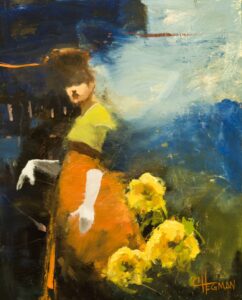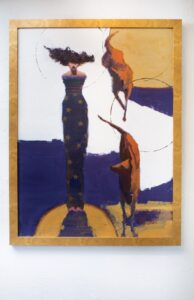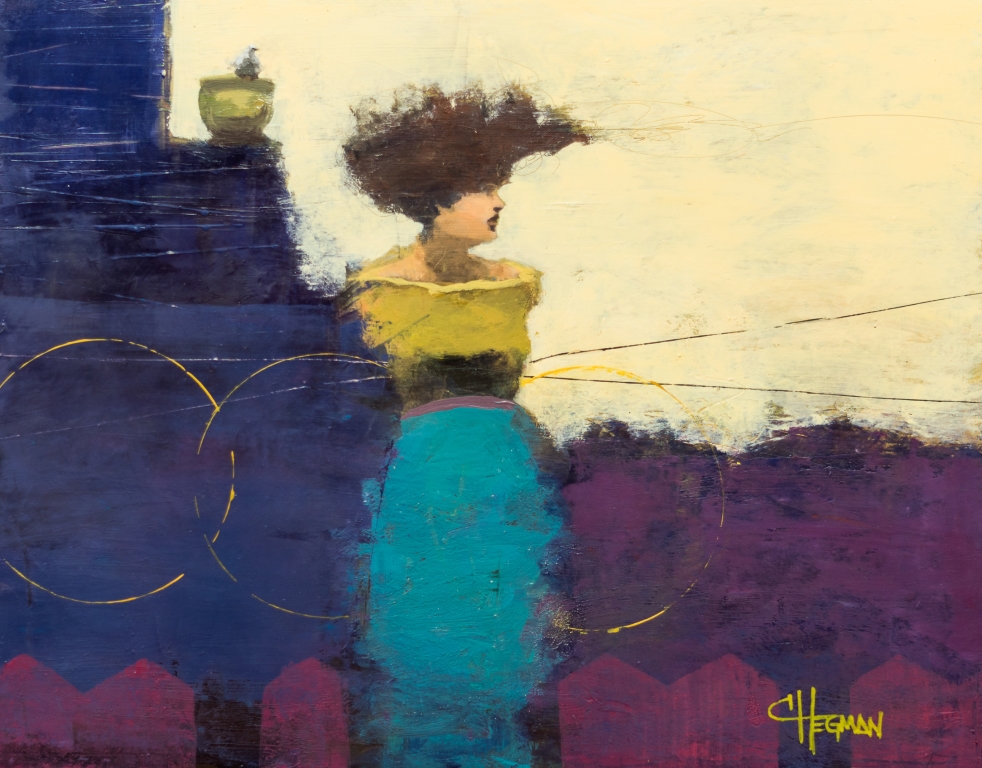Writer Rebecca L. Rhoades



The human form has been a centerpiece of art for thousands of years. Whether in early cave paintings that depict hunters in a few simple strokes or hyperrealistic portraiture by modern masters, the figure tells stories, expresses beliefs — and simply explores everyday life.
Cathy Hegman, a Mississippi-based contemporary artist, has been creating in the figurative genre for much of her career. According to her artist statement, the internationally recognized painter, teacher and author “paints figures that embody no particular persona but comprise bits, pieces and faces of those who have in some way marked (her) journey.” Her works are contemplative yet expressive, enigmatic yet sincere, moody yet playful.



Stories in Paint
At first glance, Hegman’s paintings appear simple: A figure, usually a solitary woman, stands against a minimalist landscape, her long gown billowing around her and melting into the background, her tousled curls or headdresses stretching outward like the lush foliage of summer flora.
But look closer, and meticulous details come to life.
Layers of oil, acrylic or watercolor — in bold jewel tones and soothing earthen hues — build on each other, resulting in scumbled texture full of depth, movement and intensity. With each new work, the artist begins by layering the paint; as the canvas develops, the image reveals itself.
“I’m more interested in the process of building a painting up,” Hegman says. “The content comes after I’ve already started. I don’t start out thinking about what I’m painting or anything like that. I just start out with designing something on the two-dimensional surface.”
Large swaths of deeply saturated pigments fill the canvas. From far away, each appears as a bold monochromatic shade. But further inspection reveals shadows and highlights, contrasting shades, and overlapping scratches and brushstrokes of complementary hues. Specs of pinks and oranges peek out through deep blues. White backgrounds are formed from layers of blues, grays, greens and taupes. Even blacks showcase rich blends of purples, reds, teals and golds.
“You won’t ever find a passage in my work that is one color,” Hegman says. “It’s always layers upon layers upon layers. I love the changing and morphing a painting will take until it’s finished.”
Patterns are superimposed on top of each other randomly, creating new and intricate finishes.
“By the time you layer 20 or 30 patterns on top of each other, it becomes more or less a texture,” says the artist, who uses stencils, rollers, rubber stamps, cups, lids and “anything not nailed down” to create markings that are then blurred with knives and spatulas.
“If you don’t completely obliterate each layer, it gives life to the painting. You’re seeing one thing, and then you’re seeing another. It makes it so much more interesting. It makes it breathe in and out as you’re looking at it.”
An Emotional Approach
Many figurative artists strive for anatomical correctness, for a recognizable likeness that viewers can easily place in their minds. But for Hegman, her work is more about the emotions it evokes.



“I know how to replicate something, but I don’t want to do that,” she says. “I’m not painting things. I’m painting the feeling I have about things.”
There’s a mystique to her characters.
“In all of my figurative work, I think from the first one I ever painted, I’ve always left things out that I didn’t think were necessary,” she explains. Eyes are shrouded or shaded out. “My goal is to paint something you haven’t seen before, and the eyes make it too definitive. I want the anonymity.”
Upper arms and legs often are absent. Hands usually are covered in long white opera-style gloves.
“I paint hands because hands are descriptive,” the artist remarks. “They’re a good device to show movement or action in the painting. But the upper arms, I find that I just don’t need those. And a lot of times, it’s the same with legs. You don’t have to give everybody everything. They can fill in the blanks when they need to.”
For her series “Big Skirts,” Hegman drew inspiration from the memories of a woman who was her childhood caretaker and who wore flowing skirts. After the woman’s death, the artist began working the concept of the voluminous garment into her work.
“Everything is based on something that happened or someone who came along in my life,” she says. “And it worked beautifully. And as the skirts got bigger and the headdress got bigger, the balance got better.”
The wide swoops and sweeping trains of the bell-shaped skirts are echoed in the figures’ wild and windblown hairstyles. The look is a mesmerizing blend of surrealistic fantasy and haute couture — one that is as much at home in a collection of modern art as it is on the wall of a Hollywood regency-style penthouse.
“I’m basically using a shape that fits well on the canvas,” Hegman says. “I needed to give them something that would balance them out. It’s not really hair. It’s kind of like their world. A lot of times, there will be things embedded in there that will tell a story about who they are — a bird’s nest or a tree. It’s their thoughts and their thoughts on the world. Almost all of them have that now.”
The artist began to incorporate the distinctive headdress shapes in her 2009 series, “Weight of Balance.” In it, figures are perched on arcs or orb; the large hair or headdress adding symmetry to the proportions — literally and figuratively.
“It’s so apropos for the world in general,” Hegman notes. “We’re always trying to be in balance, and it’s so momentary. It doesn’t last.”
Hegman also frequently adds animals, butterflies and flowers to her scenes. A single white dove, vibrant orange koi, or a small dog or rabbit — even a group of coral-hued flamingos — creates a unity between humans and nature, enhancing the figure’s vulnerability and giving the viewer another way to connect with the canvas.
“The beauty of art is the ability to put yourself into it and be able to relate to it,” Hegman says. “I do feel like most of my work reflects the fact that nature and our surroundings are what form us. Everything in my work is in some form a part of my life. It’s almost this autobiography that’s been going on for the past 38 years.”
Cathy Hegman’s Mysterious and Romantic Dreams in Paint
Thursday, Jan. 18 // 4–7 p.m. // Grace Renee Gallery // 7212 E. Ho Hum Road, Carefree // Free // 480-575-8080 // gracereneegallery.com







Comments by Admin